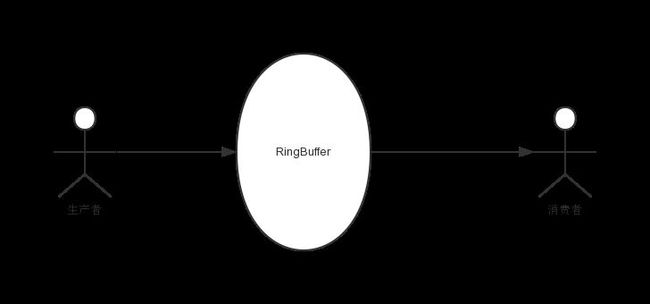Disruptor使用入门
在最近的项目中看到同事使用到了Disruptor,以前在ifeve上看到过关于Disruptor的文章,但是没有深入研究,现在项目中用到了,就借这个机会对这个并发编程框架进行深入学习。项目中使用到的是disruptor-2.10.4,所以下面分析到的Disruptor的代码是这个版本的。
并发编程网介绍Disruptor的文章是disruptor1.0版本,所以有一些术语在2.0版本上已经没有了或者被替代了。
Disruptor术语
github上Disruptor的wiki对Disruptor中的术语进行了解释,在看Disruptor的过程中,对于几个其他的类,觉得有必要与这些术语放到一起,就加进来了。
-
RingBuffer经常被看作Disruptor最主要的组件,然而从3.0开始RingBuffer仅仅负责存储和更新在Disruptor中流通的数据。对一些特殊的使用场景能够被用户(使用其他数据结构)完全替代。 -
SequenceDisruptor使用Sequence来表示一个特殊组件处理的序号。和Disruptor一样,每个消费者(EventProcessor)都维持着一个Sequence。大部分的并发代码依赖这些Sequence值的运转,因此Sequence支持多种当前AtomicLong类的特性。事实上,这两者之间唯一的区别是Sequence包含额外的功能来阻止Sequence和其他值之间的共享。 -
Sequencer这是Disruptor真正的核心。实现了这个接口的两种生产者(单生产者和多生产者)均实现了所有的并发算法,为了在生产者和消费者之间进行准确快速的数据传递。 -
SequenceBarrier由Sequencer生成,并且包含了已经发布的Sequence的引用,这些的Sequence源于Sequencer和一些独立的消费者的Sequence。它包含了决定是否有供消费者来消费的Event的逻辑。 - WaitStrategy:它决定了一个消费者将如何等待生产者将Event置入Disruptor。
-
Event从生产者到消费者过程中所处理的数据单元。Disruptor中没有代码表示Event,因为它完全是由用户定义的。 -
EventProcessor主要的事件循环,用于处理Disruptor中的Event,并且拥有消费者的Sequence。它有一个实现类是BatchEventProcessor,包含了event loop有效的实现,并且将回调到一个EventHandler接口的实现对象。 -
EventHandler由用户实现并且代表了Disruptor中的一个消费者的接口。 -
Producer由用户实现,它调用RingBuffer来插入事件(Event),在Disruptor中没有相应的实现代码,由用户实现。 -
WorkProcessor确保每个sequence只被一个processor消费,在同一个WorkPool中的处理多个WorkProcessor不会消费同样的sequence。 -
WorkerPool一个WorkProcessor池,其中WorkProcessor将消费Sequence,所以任务可以在实现WorkHandler接口的worker吃间移交 -
LifecycleAware当BatchEventProcessor启动和停止时,于实现这个接口用于接收通知。
Disruptor印象
初看Disruptor,给人的印象就是RingBuffer是其核心,生产者向RingBuffer中写入元素,消费者从RingBuffer中消费元素,如下图:

这就是Disruptor最简单的模型。其中的RingBuffer被组织成要给环形队列,但它与我们在常常使用的队列又不一样,这个队列大小固定,且每个元素槽都以一个整数进行编号,RingBuffer中只有一个游标维护着一个指向下一个可用位置的序号,生产者每次向RingBuffer中写入一个元素时都需要向RingBuffer申请一个可写入的序列号,如果此时RingBuffer中有可用节点,RingBuffer就向生产者返回这个可用节点的序号,如果没有,那么就等待。同样消费者消费的元素序号也必须是生产者已经写入了的元素序号。
那么Disruptor是如何实现这些逻辑的呢?先来看一个Disruptor的使用示例
Disruptor使用示例
不适用Disruptor的dsl,直接使用Disruptor中的类来完成。
//RingBuffer中存储的单元
public class IntEvent {
private int value = -1;
public int getValue() {
return value;
}
public void setValue(int value) {
this.value = value;
}
public String toString() {
return String.valueOf(value);
}
public static EventFactory<IntEvent> INT_ENEVT_FACTORY = new EventFactory<IntEvent>() {
public IntEvent newInstance() {
return new IntEvent();
}
};
}
//生产者
public class IntEventProducer implements WorkHandler<IntEvent> {
private int seq = 0;
public void onEvent(IntEvent event) throws Exception {
System.out.println("produced " + seq);
event.setValue(++seq);
}
}
//消费者
public class IntEventProcessor implements WorkHandler<IntEvent> {
public void onEvent(IntEvent event) throws Exception {
System.out.println(event.getValue());
event.setValue(1);
}
}
public class DisruptorTest {
public static void main(String[] args) throws InterruptedException {
//创建一个RingBuffer对象
RingBuffer<IntEvent> ringBuffer = new RingBuffer<IntEvent>(IntEvent.INT_ENEVT_FACTORY,
new SingleThreadedClaimStrategy(16),
new SleepingWaitStrategy());
SequenceBarrier sequenceBarrier = ringBuffer.newBarrier();
IntEventProducer[] producers = new IntEventProducer[1];
for (int i = 0; i < producers.length; i++) {
producers[i] = new IntEventProducer();
}
WorkerPool<IntEvent> crawler = new WorkerPool<IntEvent>(ringBuffer,
sequenceBarrier,
new IntEventExceptionHandler(),
producers);
SequenceBarrier sb = ringBuffer.newBarrier(crawler.getWorkerSequences());
IntEventProcessor[] processors = new IntEventProcessor[1];
for (int i = 0; i < processors.length; i++) {
processors[i] = new IntEventProcessor();
}
WorkerPool<IntEvent> applier = new WorkerPool<IntEvent>(ringBuffer,sb,
new IntEventExceptionHandler(),
processors);
List<Sequence> gatingSequences = new ArrayList<Sequence>();
for(Sequence s : crawler.getWorkerSequences()) {
gatingSequences.add(s);
}
for(Sequence s : applier.getWorkerSequences()) {
gatingSequences.add(s);
}
ringBuffer.setGatingSequences(gatingSequences.toArray(new Sequence[gatingSequences.size()]));
ThreadPoolExecutor executor = new ThreadPoolExecutor(7,7,10,TimeUnit.MINUTES,new LinkedBlockingQueue<Runnable>(5));
crawler.start(executor);
applier.start(executor);
while (true) {
Thread.sleep(1000);
long lastSeq = ringBuffer.next();
ringBuffer.publish(lastSeq);
}
}
}
class IntEventExceptionHandler implements ExceptionHandler {
public void handleEventException(Throwable ex, long sequence, Object event) {}
public void handleOnStartException(Throwable ex) {}
public void handleOnShutdownException(Throwable ex) {}
}
在上面的代码中IntEvent类就是术语中的Event,IntEventProducer对应Producer,IntEventProcessor对应着EventProcessor,也就是消费者,但是IntEventProcessor类并不是实现的IntEventProcessor接口,这个下面会分析到。
下面从main方法开始分析。
首先是RingBuffer的创建, RingBuffer<IntEvent> ringBuffer = new RingBuffer<IntEvent>(IntEvent.INT_ENEVT_FACTORY,new SingleThreadedClaimStrategy(16), new SleepingWaitStrategy());RingBuffer的构造方法的第一个参数是实现了EventFactory接口的类,主要作用是创建IntEvent对象,在创建RingBuffer对象时,第二个参数是 ClaimStrategy,生产者通过 ClaimStrategy 来申请下一个可用节点,第三个参数是 WaitStrategy的实现类,它定义了消费者的等待策略。
下面一段代码是初始化生产者的过程
SequenceBarrier sequenceBarrier = ringBuffer.newBarrier();
IntEventProducer[] producers = new IntEventProducer[1];
for (int i = 0; i < producers.length; i++) {
producers[i] = new IntEventProducer();
}
WorkerPool<IntEvent> crawler = new WorkerPool<IntEvent>(ringBuffer,
sequenceBarrier,new IntEventExceptionHandler(), producers);
ringBuffer.newBarrier()返回的是一个SequenceBarrier对象,Barrier顾名思义就是障碍的意思,这个障碍阻止了生产者越过其所能到达的ringbuffer中的位置。RingBuffer在执行过程中会维持一个游标cursor,所以生产者从RingBuffer中获取到的的游标必须小于等于这个cursor。
然后就是消费者的初始化:
SequenceBarrier sb = ringBuffer.newBarrier(crawler.getWorkerSequences());
IntEventProcessor[] processors = new IntEventProcessor[1];
for (int i = 0; i < processors.length; i++) {
processors[i] = new IntEventProcessor();
}
WorkerPool<IntEvent> applier = new WorkerPool<IntEvent>(ringBuffer,sb,new IntEventExceptionHandler(),processors);
消费者初始化也需要设置一个SequenceBarrier对象,这个SequenceBarrier对象指明了消费者可以消费的元素序号,如果消费者的游标大于这个序号,那么消费者必须以 WaitStrategy定义的策略等待。
生产者和消费者创建完成后下一步是设置 RingBuffer的一个变量 gatingSequences, gatingSequences的作用是防止生产者覆盖还未被消费者消费的元素,假设一个RingBuffer的大小为8,消费者消费速度较慢,那么RingBuffer可能是满的,当生产者向RingBuffer申请下一个可用序号时,还未被消费者消费的序号就不能被覆盖,所以RingBuffer就不能给生产者返回可用序号,此时消费者线程就进入等待,在这种情况下RingBuffer会检查当前申请的序号是否大于 gatingSequences中的最小序号,如果当前申请的序号大于最小序号,那么生产者就等待。代码如下:
List<Sequence> gatingSequences = new ArrayList<Sequence>();
for(Sequence s : crawler.getWorkerSequences()) {
gatingSequences.add(s);
}
for(Sequence s : applier.getWorkerSequences()) {
gatingSequences.add(s);
} ringBuffer.setGatingSequences(gatingSequences.toArray(new Sequence[gatingSequences.size()]));
这里之所以加入了生产者的序号,是因为在多生产者的情况下,一个生产者不能覆盖另一个生产者已经申请的序号。
然后下面一段的代码就是启动Disruptor线程来执行生产者和消费者线程。
ThreadPoolExecutor executor = new ThreadPoolExecutor(7, 7,10, TimeUnit.MINUTES, new LinkedBlockingQueue<Runnable>(2)); crawler.start(executor); applier.start(executor);
最后要做的是生产者不断的申请可用序号,提交准备好的元素序号,即:
while (true) {
Thread.sleep(1000);
long lastSeq = ringBuffer.next();
ringBuffer.publish(lastSeq);
}
这个过程一般成为两阶段提交,第一个阶段调用RingBuffer.next()方法得到下一个可用节点,此时会调用生产者类的OnEvent方法,即IntEventProducer.onEvent(),第二个阶段是发布已经生产完成的元素序号lastSeq,提醒消费者,可以消费这个序号了。
小结
本文简要介绍了Disruptor的一些术语,解释了一个Disruptor示例程序执行过程的各个要点,从宏观上了解了Disruptor的执行流程,在下一篇文章中接着分析Disruptor的内部执行原理。
Reference
并发框架Disruptor译文
JAVA并发编程学习笔记之Unsafe类
从 Java 代码到 Java 堆
Disruptor的GitHub
Disruptor使用指南